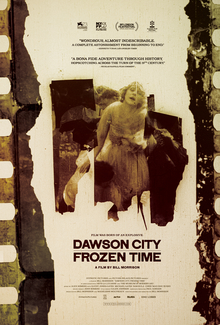Dawson City: Frozen Time
| Dawson City: Frozen Time | |
|---|---|
 Film poster | |
| Directed by | Bill Morrison |
| Written by | Bill Morrison |
| Produced by | Bill Morrison Madeleine Molyneaux |
| Edited by | Bill Morrison |
| Music by | Alex Somers |
Production companies | Hypnotic Pictures Picture Palace Pictures |
| Distributed by | Kino Lorber Cineteca Bologna |
Release date |
|
Running time | 120 minutes |
| Country | United States |
| Language | English |
| Box office | $111,619[1] |
Dawson City: Frozen Time is a 2016 American documentary film written, edited, and directed by Bill Morrison,[2] produced by Morrison and Madeleine Molyneaux.[3] First screened in the Orizzonti competition section at the 73rd Venice International Film Festival,[4] the film details the history of the remote Yukon town of Dawson City, from the Klondike Gold Rush to the 1978 Dawson Film Find: a discovery of 533 nitrate reels containing numerous lost films. The recovered silent films, buried beneath a hockey rink in 1929,[5][6] included shorts, features, and newsreel footage of various events, such as the 1919 World Series.[7]
Synopsis
The 1978 discovery of 533 reels of nitrate film beneath the permafrost of a decommissioned swimming pool, later known as the Dawson Film Find, serves to frame a narrative of the Canadian gold rush, the dawn of 20th century America, and Hollywood in the silent era.
Contents of the unearthed reels help portray the story of Dawson City: how native lands of the Trʼondëk Hwëchʼin became a frontier, a boomtown, and an entertainment hub, before industrial monopolies and poverty of resources ensued. The 1957 documentary City of Gold captured Dawson in the shadow of its former glory.
The film utilizes a number of silent film techniques, consistent with the subject matter, including
Themes
The film begins with a description of the dangers of flammable
Production
Bill Morrison had initially envisioned the project to be similar to his 12-minute film The Film of Her (1996), but came to envision a broader scope as time went on. Kathy Jones and Michael Gates, employees of the Dawson Museum and
Critical response
Dawson City: Frozen Time has received positive reviews from critics. Rotten Tomatoes reports a 100% approval rating based on 62 reviews, with a weighted average of 8.10/10. The site's consensus reads: "Dawson City: Frozen Time takes a patient look at the past through long-lost film footage that reveals much more than glimpses at life through the camera's lens".[12] Dawson City: Frozen Time appeared on more than 100 critics' lists of the best films of 2017,[13] and on numerous lists of the best films of the 2010s, including those from the Associated Press,[14] Los Angeles Times (Kenneth Turan),[15] and Vanity Fair (Richard Lawson).[16] Kenneth Turan of the Los Angeles Times wrote, "If you love film, if you’re intoxicated by the way movies combine image and emotion, be prepared to swoon."[17] Deborah Eisenberg, writing in the New York Review of Books, summarized: "Dawson City: Frozen Time is nominally a documentary—it is a documentary—but describing it as a documentary is something like describing Ulysses as a travel guide to Dublin. The film is transfixing, an utterly singular compound of the bizarre, the richly informative, the thrilling, the horrifying, the goofy, the tragic, and the flat-out gorgeous."[18] Glenn Kenny of The New York Times praised the film "as an instantaneously recognizable masterpiece."[19]
References
- Internet Movie Database. Retrieved August 28, 2017.
- ^ "Dawson City: Frozen Time". Picture Palace Pictures. September 19, 2016. Archived from the original on October 8, 2014. Retrieved September 19, 2016.
- ^ TCM.com
- ^ "La Biennale di Venezia - Orizzonti". Archived from the original on October 4, 2016. Retrieved August 21, 2016.
- ^ Weschler, Lawrence (September 14, 2016). "The Discovery, and Remarkable Recovery, of the King Tut's Tomb of Silent-Era Cinema". Vanity Fair. Retrieved July 20, 2017.
- ^ "Lost and Found no. 2 – Dawson City". The Bioscope. September 19, 2016. Retrieved September 19, 2016.
- ^ "Footage of scandalous 1919 World Series saved by Yukon permafrost". CBC News. September 19, 2016. Retrieved September 19, 2016.
- ^ Morrison, Bill (2016). Dawson City: Frozen Time. KinoLorber. p. 1:53:45.
- ^ The Filmmaker as Miner: An Interview with Bill Morrison on JSTOR (Bill Morrison and Scott MacDonald Cinéaste Vol. 42, No. 1 (Winter 2016), pp. 40-43)
- ^ The Filmmaker as Miner: An Interview with Bill Morrison on JSTOR (Bill Morrison and Scott MacDonald Cinéaste Vol. 42, No. 1 (Winter 2016), pp. 40-43)
- ^ The Filmmaker as Miner: An Interview with Bill Morrison on JSTOR (Bill Morrison and Scott MacDonald Cinéaste Vol. 42, No. 1 (Winter 2016), pp. 40-43)
- ^ "Dawson City: Frozen Time". Rotten Tomatoes. January 21, 2023.
- ^ "Dawson City: Frozen Time awards and year-end lists". Hypnotic Pictures. December 31, 2019.
- ^ Coyle, Jake (December 13, 2017). "'Tree of Life' tops AP's best 10 films of the decade". Associated Press.
- ^ Turan, Kenneth (December 30, 2017). "The best movies of the decade: Kenneth Turan and Justin Chang's essential picks". Los Angeles Times.
- ^ Lawson, Richard (November 26, 2017). "The 10 Best Movies of the 2010s: Richard Lawson's List". Vanity Fair.
- ^ Turan, Kenneth (June 15, 2017). "'Dawson City: Frozen Time' details the astonishing discovery of a treasure-trove of forgotten film". Los Angeles Times.
- ISSN 0028-7504. Retrieved October 4, 2019.
- ^ Kenny, Glenn (June 8, 2017). "In 'Dawson City: Frozen Time,' Early Movies Lost and Found". The New York Times.
